Let's drive a mammoth into a hole: how to make a presentation so that you can be heard and remembered
Many of us have been to IT conferences. And if they did not, then they probably watched the broadcasts, recordings or read the transcripts of the reports on Habré. Do you know which reports become hits even on the most hardcore events? The insides of complex technology? Not. DevOps? By no means. Most often, the audience viewers take the so-called keynote reports - presentations of people who are not necessarily related to IT. It’s not a beautiful presentation, not even a speaker’s charisma, but that these guys know the secret of SUCCES. No, we are not sealed.
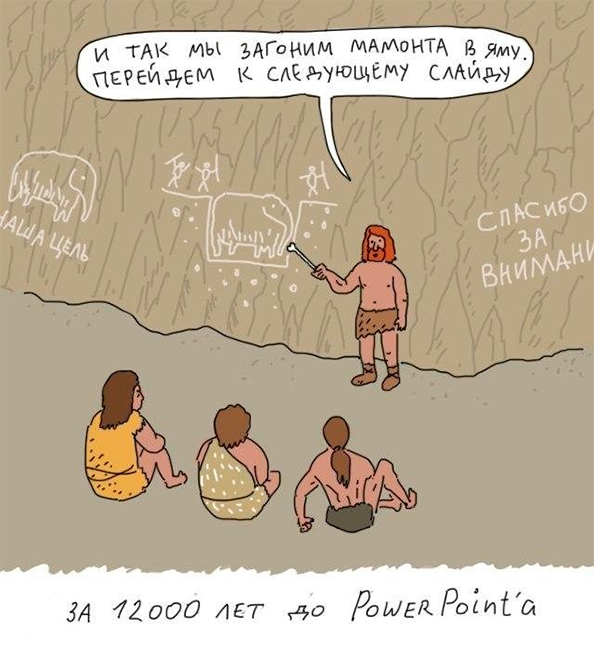 Source: Duran
Source: Duran
Presentations in the modern IT-world face and techies, and salespeople, and top management. This can be a short pitch in front of investors, a new product presentation or a long training lecture. Now imagine how many presentations are there for internal and external listeners, clients, students, etc. conducts a company of this magnitude, as LANIT. Obviously, we have come a long way (to be honest, according to the sensations - we ran the marathon more) and collected a lot of bumps before we learned to make presentations that hit the target and did what they should do: train, sell, inform. And, most importantly, the audience remembers them. We were lucky - on this way we got a real guru of preparing and conducting presentations - Dmitry Izmestyev, vice president of innovation projects at LANIT (by the way, here is his big interview about innovations ).
There are only six principles, observing which, you can make the best presentation in the world. You will be listened to and memorized everything you said. We took Dmitry's training workshop as a basis (2 hours and 15 minutes), clarified some information, added some of our ideas and experience, and prepared for you a detailed interpretation of the word SUCCES, written with a typo. Let's spell it.
')
Simplicity is the first principle of presentation that needs attention. Children's disease of the majority of the presentation - a large amount of content and the inability of the author to answer the question: "And what is the main idea of this presentation?"
This is precisely the principle of simplicity. Nobody urges you to speak only in simple words or remove complex schemes from a presentation, especially in the same IT sphere, simplification is often impossible. But the presentation should have a simple, well-articulated idea that you have to convey to the audience so that it will be heard and accepted.
You should not try to shove all your experience into the presentation. There are certain recommendations for speeches: so, if you have only 15 minutes, then it is better to give the audience only one idea (in the most critical situation - a maximum of three). But this does not mean that in 2 hours you can broadcast 24 theses. Maximum - 7-8, more audience simply will not accept.

Here is a great example of how very complex information is very simple to present. What could be more difficult than the birth and development of a new man and the hormonal changes accompanying him in the woman's body? But the "priborchik" gives a simple and clear answer: pregnant or not. By the way, this simplicity is especially important at this moment, usually associated with stress, anxiety, difficulties.
Making it simple is insanely difficult. How to throw out at least a line from the native and tortured presentation? Therefore, our advice is to first do everything as you intended, to sketch out a plan or text, prepare slides, and after that mercilessly cut off all unnecessary. Do not be afraid - even a diamond loses some of its mass during cutting. As a result, there should remain simple, intelligible, clearly worded information.
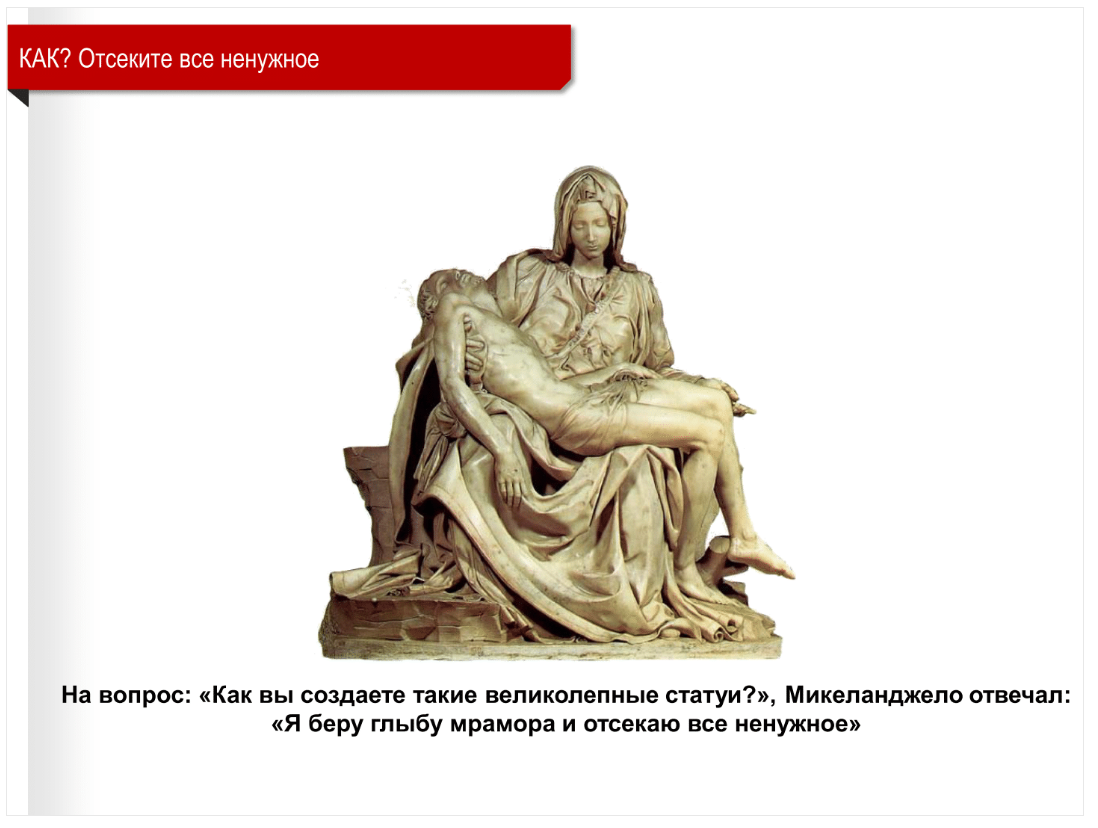
You have experience and information, create masterpieces of them, cutting off the superfluous.
There are other ways to convey a complex concept simply and clearly. For example, explaining new unfamiliar concepts through analogies and metaphors.
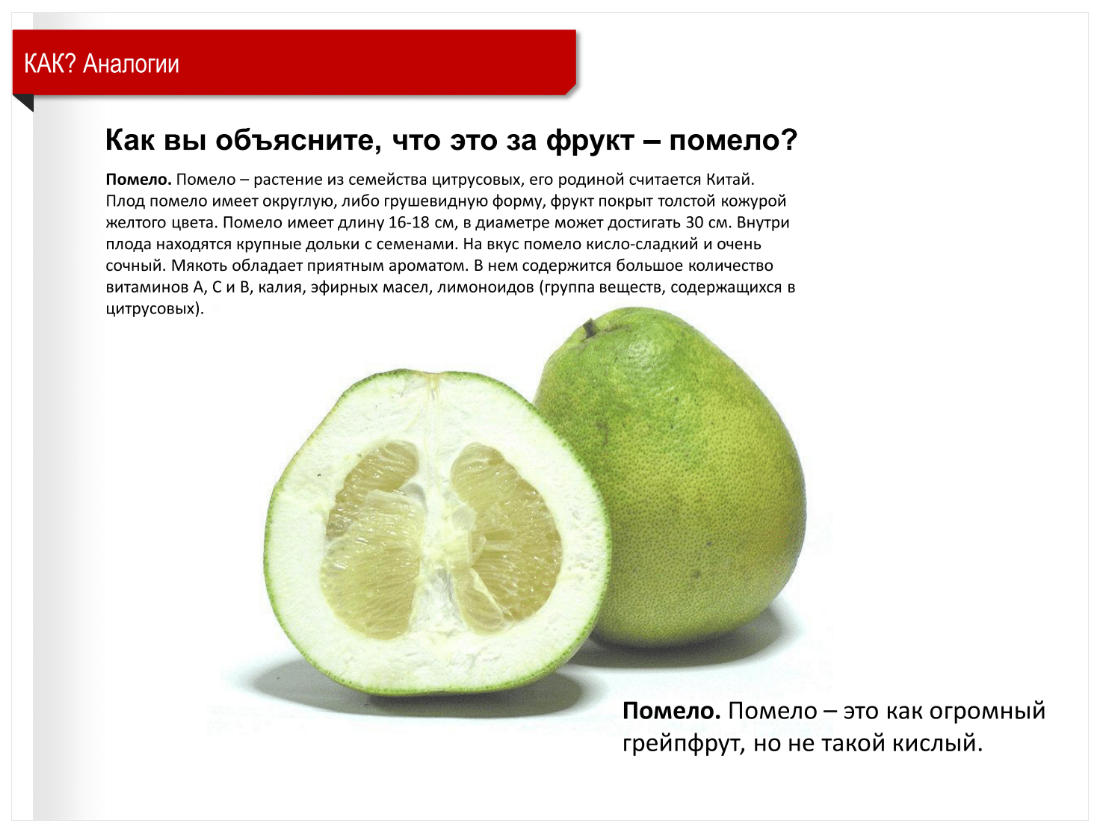
Than to give complex explanations, it is better to build an analogy with information already known to listeners. It will be clearer and clearer.
So, the first rule: to cut off all unnecessary in a speech and on slides, to do is simple, but not primitive. And no more than 1-3 main ideas for a 15-minute presentation.
It is surprises, shakes usually not enough in the speeches of novice speakers. A consistent logical report is the worst thing you can do to attract the attention of the audience. Imagine if detectives told the same way consistently and logically from the moment of the murder to the moment of solving the crime. No, the best authors always use secrets, intrigue, which makes us turn over the pages and stay up until you finish reading the book.
Creating a suspense in a presentation is high class. But creating at least minimal intrigue in order to capture the attention of the audience is not such a complicated skill. If you succeed, the attention of the public is guaranteed. After all, attention is the door through which the speaker's information enters. Here are some tips on how to achieve this:
Understand the principle? Standard cadres familiar to military subjects do not portend anything unusual, I even want to stop looking, but suddenly everything changes.
Do you think this will happen only in advertising? Not at all, the same principle is easy to apply in a presentation. Here is a great example. What is expected of you at the presentation? Slides, right? Break this stereotype and tell the audience everything on the example of some ordinary subject. Even a shoe will do. This is how Terry Moore did it gracefully in his speech, telling the audience that most of them simply do not know how to tie shoelaces (video, unfortunately, only in English):
The second rule: To “fill” your listeners with something new, you need to create a “gap” in their ideas about the world using the effect of surprise, to show that there is a question to which they do not know the answer. Only after that they are ready to accept new information. To apply the two principles together, formulate the basic idea that you want to convey to the audience, then find something counterintuitive, fool the audience, create a “gap” in their knowledge and “fill” your idea there.
No business presentation will cost anything if it has no specifics. Moreover, it should be data of various kinds: facts, figures, diagrams, quotations of experts, etc. In principle, there is not even much to explain here, because for some reason, there is enough concrete in the IT sphere.
However, you should take care of competent visualization of the data that you have. Let's look at an example.

Art Silverman made the important discovery that popcorn can be dangerous.
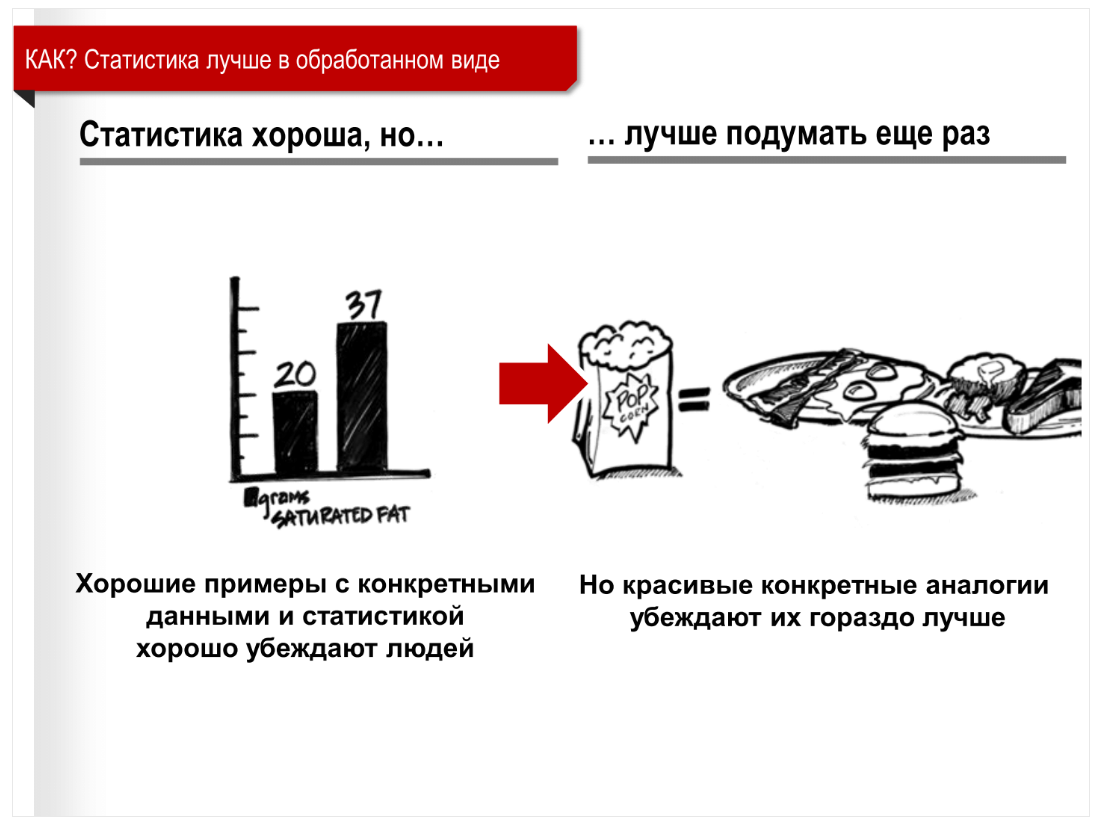
How to talk about the dangers of popcorn? It is possible to present all the numbers as graphs And it can be even clearer by showing that one portion of popcorn contains as much saturated fat as bacon and eggs, big mack and lunch with a steak combined. No more eating popcorn.
At the end of the section on each principle, we began to write how to apply all principles together. And here we have an unexpected problem. As soon as the authors of presentations understand the first two principles - simplicity and surprises, they leave inspired, rework the presentation, it becomes beautiful and sparkling, but ... usually completely loses all the specific information. In no case do not allow this!
The third principle: in addition to the main idea and unexpected turns, a good presentation always contains a lot of specific information, but it is better to think again how to present it in a creative way.
The presentation should definitely inspire confidence among the audience. Here are a few things that significantly increase the level of confidence in the information (by the way, this applies to the design of sites and texts):
We will not put on the list, but we will carry out separately a very important element of trust for IT companies - prototypes. Now there are many programs and tools to prepare prototypes of your program or hardware for pictures in a presentation. Anyway, then there will be TK, anyway, to remake, but the presence of prototypes makes a truly indelible impression on the audience: it creates the feeling that the product is here, almost in the hands. Do not be lazy to make detailed prototypes for presentations - these are reasonable efforts.
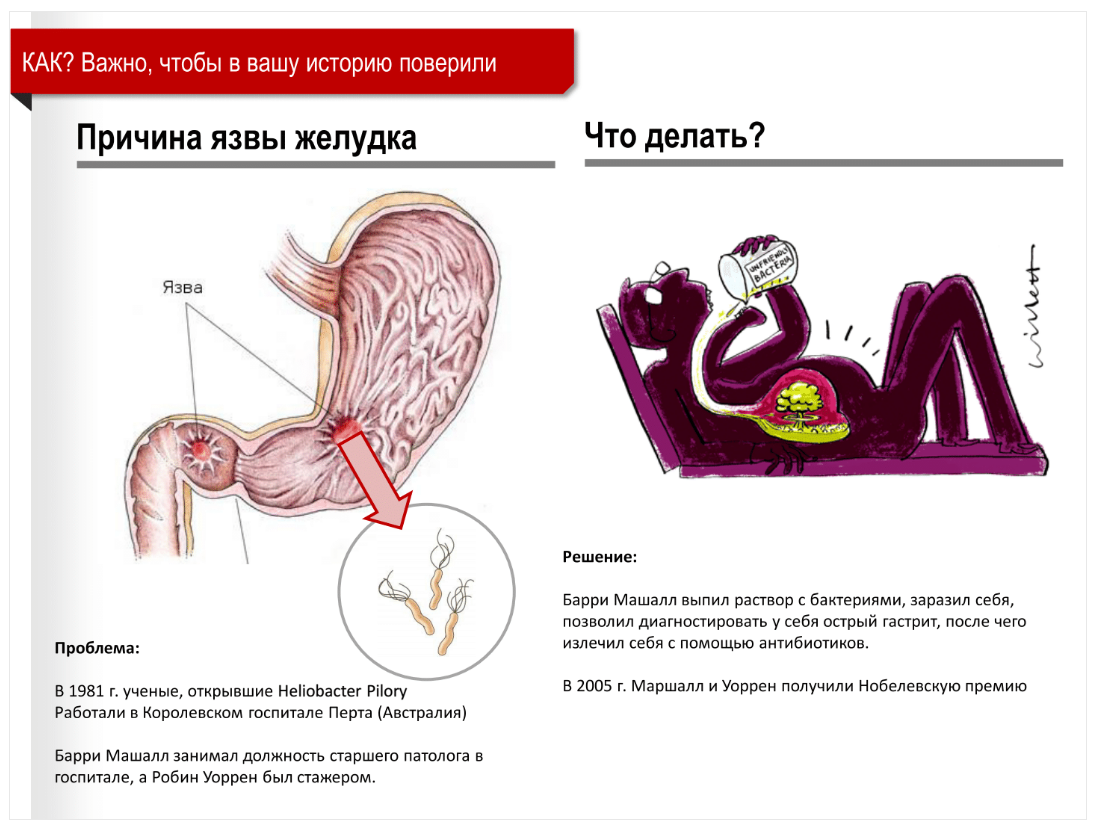
We, IT professionals, are often lazy about making prototypes, but sometimes a demonstration is the best way ... to get the Nobel Prize. So, until the 1980s, it was believed that a stomach ulcer is caused by stress and unhealthy diet. However, pathologist Barry Marshall and his trainee Robin Warren found that Helicobacter Pylori was responsible for this. What do you think, what were the chances of two unknown medical people from the distant city of Perth to convince the medical community of the whole world? None Therefore, instead of convincing, they resorted to a very clear demonstration.
Another important point that concerns trust is work with details. Include small, accurate details in the presentation and presentation. Let us explain on a textbook example from legal practice.
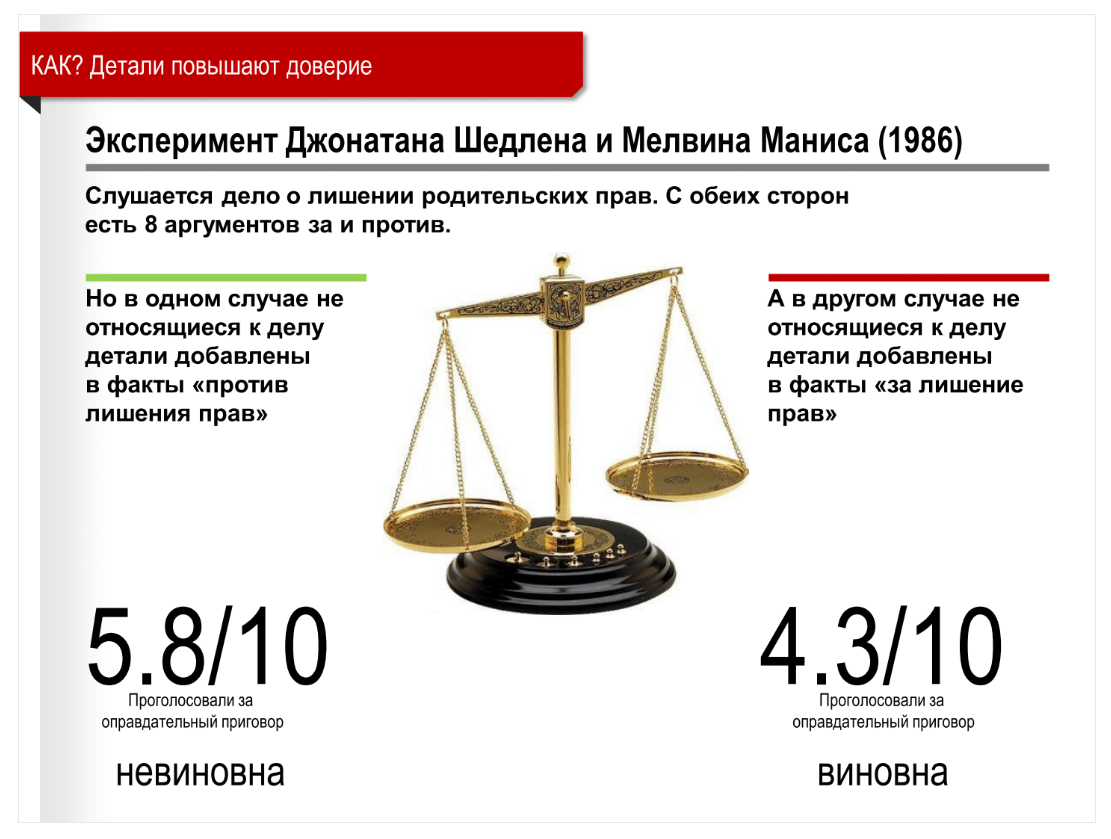
For the experiment gathered two groups of jurors. Before them in the case of depriving the mother of parental rights (such a terrible case was specifically chosen), a lawyer and a prosecutor spoke out, who set forth exactly 8 arguments each. In the first case, the speech of the lawyer, and in the second case, the prosecutor was attended by details that had no relation to the merits of the case. For example, it was said not “the mother beat the child”, but “and that when on the morning of August 5 he was brushing his teeth with his tiny brush with Mickey Mouse, she attacked him with her fists”. And the jury made a decision in favor of the defense or the prosecution, depending on who was currently stating the situation with exact details. Human freedom depended only on the amount of detail in the speech of a lawyer.
To summarize, after you have inserted all the necessary information into your presentation, do the revision again and make sure that all the facts you have stated do not “hang in the air”, but are stated so that they inspire confidence in the audience.
Try to evoke an audience’s emotions, affect the emotional background. The simplest emotion is, of course, laughter. Look for funny quotes, jokes, appropriate jokes (intellectual or not so - according to the situation) and add them to the story. So you will defuse the situation, and attract the audience on an emotional level.
The most powerful and difficult to reach emotions are fear and tears. And if tears are applicable more likely in the social sphere or in art, then fear is quite suitable for a story in a business environment. Of course, you shouldn’t say that during the performance in the hall two snipers work, but you can tell the business owners about overspending or security holes very emotionally. And it will definitely work.
However, brilliant presentations are always made a little "on the edge." If you haven’t yet seen, see the Bill Gates presentation on the importance of malaria control:
Are you interested in the fight against malaria? If you do not live in the tropics and are not an extreme traveler, then I strongly doubt. If you are too lazy to watch all the videos, rewind to the mark of 4:54 and see how Bill Gates made everyone in the hall "turn on" instantly and think about the danger of this disease.
Bottom line: it’s not easy to cause emotions in people, but if you manage to bring them into the presentation, then you will definitely move on to the next level of interaction with the audience. Start with jokes, and then you can experiment with more complex emotions.
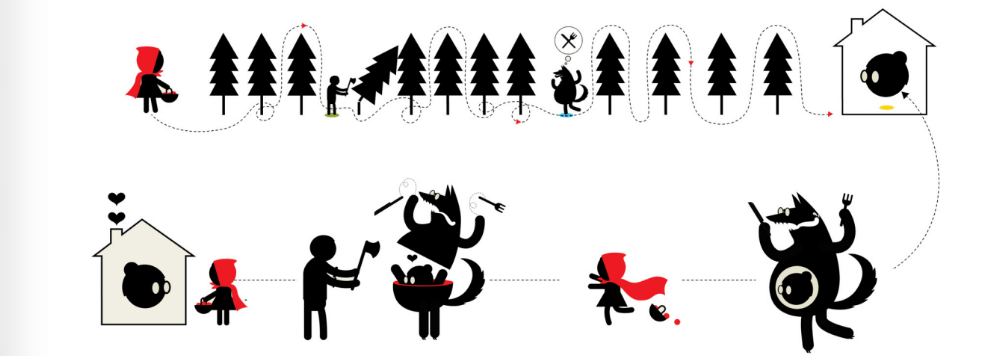
True Story of Red Cap in the form of infographics
Be sure to tell stories. People adore them. Just tell the audience: "Let's digress and I will tell you the story that happened to me." Take a look at this moment in the hall, all eyes will be fixed on you in anticipation and anticipation.
However, do not try to be too creative. Thus, an analysis of films with Oscar awards shows that awards only take 11 types of stories. And people just do not perceive too unusual stories. But here you can tell a story in a standard scenario in thousands of different ways. And here your talent as a narrator will certainly come in handy.
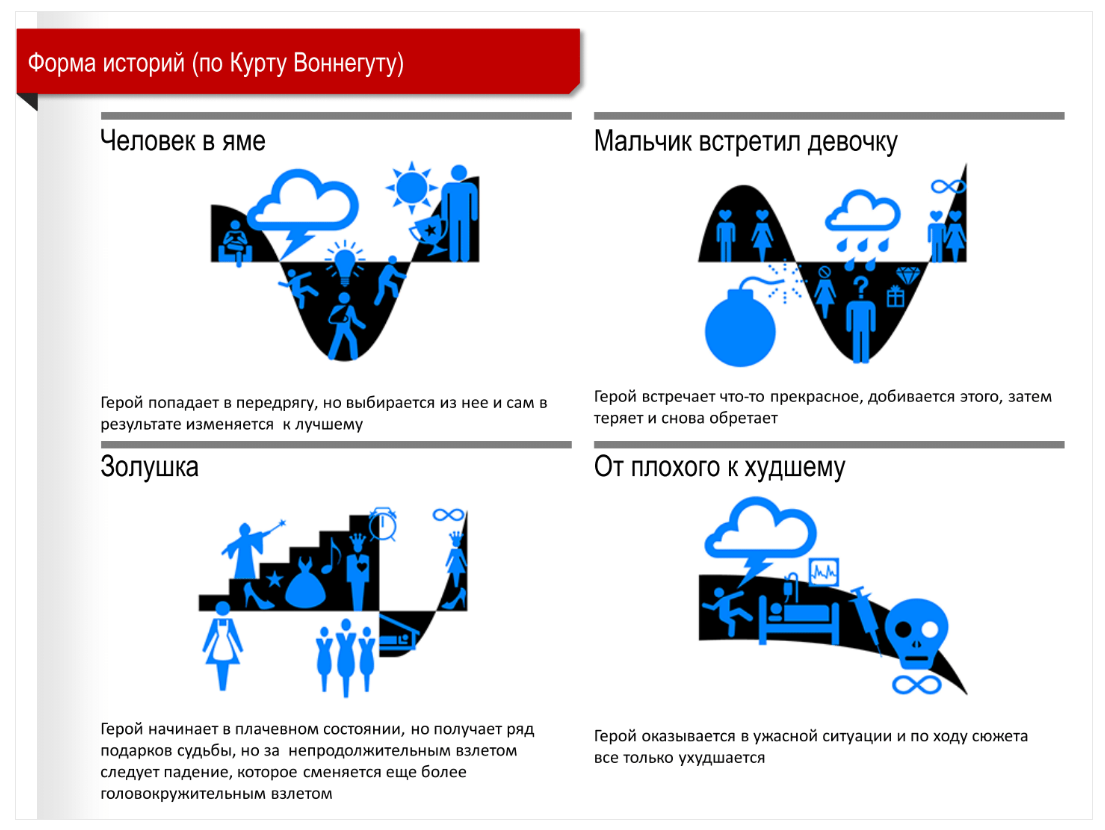
By the way, the famous writer Kurt Vonnegut considered his greatest achievement not his famous books, but the way of visualizing typical stories, here are 4 such examples.
This is the last of our principles: if you can insert life stories into your presentation, the audience will be entertained and better understand the essence of your message. And as you now know, if the story contains one important thought, elements of surprise, concrete facts and the audience will trust your words, then the audience is yours.
If in your presentation at least 2-3 principles are fulfilled, you have already overtaken competitors and drove a mammoth into a pit (interested client or investor, won the attention of listeners, etc.), the rest depends on you and the usefulness of your information. The main thing is that the listeners will remember you. By the way, did you notice that the principles described are good not only for any public speaking, but also for creating an article or a report?
Usually, Dmitri Izmestyev finishes his presentation about the presentations by showing an illustration for mnemonic memorization of how the word SUCCES formed with an error.

It's a shame for the last little S, right?
But we, listening to him, found the last letter s - and we recommend everyone to use this seventh principle of a successful presentation.
S - Smile - Smile.
PS: Dmitry in his discoveries and in the knowledge we were helped by the book of Chip and Dan Heath “Made to Stick” (why some ideas live, while others die). Be sure to find and read. Unfortunately, it has not yet been translated into Russian, but this is another reason to finish learning English. Let's duplicate the title of the book in English: Chip & Dan Heath “Made to stick”.

Presentations in the modern IT-world face and techies, and salespeople, and top management. This can be a short pitch in front of investors, a new product presentation or a long training lecture. Now imagine how many presentations are there for internal and external listeners, clients, students, etc. conducts a company of this magnitude, as LANIT. Obviously, we have come a long way (to be honest, according to the sensations - we ran the marathon more) and collected a lot of bumps before we learned to make presentations that hit the target and did what they should do: train, sell, inform. And, most importantly, the audience remembers them. We were lucky - on this way we got a real guru of preparing and conducting presentations - Dmitry Izmestyev, vice president of innovation projects at LANIT (by the way, here is his big interview about innovations ).
There are only six principles, observing which, you can make the best presentation in the world. You will be listened to and memorized everything you said. We took Dmitry's training workshop as a basis (2 hours and 15 minutes), clarified some information, added some of our ideas and experience, and prepared for you a detailed interpretation of the word SUCCES, written with a typo. Let's spell it.
')
S - Simple. Simply
Simplicity is the first principle of presentation that needs attention. Children's disease of the majority of the presentation - a large amount of content and the inability of the author to answer the question: "And what is the main idea of this presentation?"
This is precisely the principle of simplicity. Nobody urges you to speak only in simple words or remove complex schemes from a presentation, especially in the same IT sphere, simplification is often impossible. But the presentation should have a simple, well-articulated idea that you have to convey to the audience so that it will be heard and accepted.
You should not try to shove all your experience into the presentation. There are certain recommendations for speeches: so, if you have only 15 minutes, then it is better to give the audience only one idea (in the most critical situation - a maximum of three). But this does not mean that in 2 hours you can broadcast 24 theses. Maximum - 7-8, more audience simply will not accept.

Here is a great example of how very complex information is very simple to present. What could be more difficult than the birth and development of a new man and the hormonal changes accompanying him in the woman's body? But the "priborchik" gives a simple and clear answer: pregnant or not. By the way, this simplicity is especially important at this moment, usually associated with stress, anxiety, difficulties.
Making it simple is insanely difficult. How to throw out at least a line from the native and tortured presentation? Therefore, our advice is to first do everything as you intended, to sketch out a plan or text, prepare slides, and after that mercilessly cut off all unnecessary. Do not be afraid - even a diamond loses some of its mass during cutting. As a result, there should remain simple, intelligible, clearly worded information.

You have experience and information, create masterpieces of them, cutting off the superfluous.
There are other ways to convey a complex concept simply and clearly. For example, explaining new unfamiliar concepts through analogies and metaphors.

Than to give complex explanations, it is better to build an analogy with information already known to listeners. It will be clearer and clearer.
So, the first rule: to cut off all unnecessary in a speech and on slides, to do is simple, but not primitive. And no more than 1-3 main ideas for a 15-minute presentation.
U - Unexpected - Unexpectedly
It is surprises, shakes usually not enough in the speeches of novice speakers. A consistent logical report is the worst thing you can do to attract the attention of the audience. Imagine if detectives told the same way consistently and logically from the moment of the murder to the moment of solving the crime. No, the best authors always use secrets, intrigue, which makes us turn over the pages and stay up until you finish reading the book.
Creating a suspense in a presentation is high class. But creating at least minimal intrigue in order to capture the attention of the audience is not such a complicated skill. If you succeed, the attention of the public is guaranteed. After all, attention is the door through which the speaker's information enters. Here are some tips on how to achieve this:
- Ask the audience a question. This simple, at first glance, method is very effective. But even he has a few nuances. Try to ask a question so that the audience can answer it in some way, involve the audience. (For example, “Raise your hands, who thinks C ++ is steeper than Java?” That's it, you caused an internal rebellion both in sishniki and javista). But at the same time, avoid questions that the audience will not exactly find the answer to (for example, ask salespeople if they have encountered Kernel Panic in Debian). If there are no options, rhetorical questions will also work, although it is better to provoke the public to actively respond and vote. After the question, the listeners will join the thread of the story again and will listen with much more interest. Indeed, in their minds this question remained unanswered, and they will look for it in your speech.
- Cheat the audience by breaking the pattern. Take advantage of the fact that your listeners have a lot of templates in their heads, and begin to act in accordance with them, calming their vigilance. And then suddenly do something completely out of this ordinary pattern. Here's a great video showing an unexpected scrapping of the template:
Understand the principle? Standard cadres familiar to military subjects do not portend anything unusual, I even want to stop looking, but suddenly everything changes.
Do you think this will happen only in advertising? Not at all, the same principle is easy to apply in a presentation. Here is a great example. What is expected of you at the presentation? Slides, right? Break this stereotype and tell the audience everything on the example of some ordinary subject. Even a shoe will do. This is how Terry Moore did it gracefully in his speech, telling the audience that most of them simply do not know how to tie shoelaces (video, unfortunately, only in English):
- Tell the presentation as a detective. Those. not from beginning to end, but vice versa - from the very end, from intrigue, unraveling it in the course of the story. If you think that it is impossible to convey serious information, you are wrong. Renowned psychologist Robert Cialdini investigated a huge number of popular science publications telling about serious scientific problems, and showed that the best of them were written according to the laws of the detective story.
The second rule: To “fill” your listeners with something new, you need to create a “gap” in their ideas about the world using the effect of surprise, to show that there is a question to which they do not know the answer. Only after that they are ready to accept new information. To apply the two principles together, formulate the basic idea that you want to convey to the audience, then find something counterintuitive, fool the audience, create a “gap” in their knowledge and “fill” your idea there.
C - Concrete - Concrete
No business presentation will cost anything if it has no specifics. Moreover, it should be data of various kinds: facts, figures, diagrams, quotations of experts, etc. In principle, there is not even much to explain here, because for some reason, there is enough concrete in the IT sphere.
However, you should take care of competent visualization of the data that you have. Let's look at an example.

Art Silverman made the important discovery that popcorn can be dangerous.

How to talk about the dangers of popcorn? It is possible to present all the numbers as graphs And it can be even clearer by showing that one portion of popcorn contains as much saturated fat as bacon and eggs, big mack and lunch with a steak combined. No more eating popcorn.
At the end of the section on each principle, we began to write how to apply all principles together. And here we have an unexpected problem. As soon as the authors of presentations understand the first two principles - simplicity and surprises, they leave inspired, rework the presentation, it becomes beautiful and sparkling, but ... usually completely loses all the specific information. In no case do not allow this!
The third principle: in addition to the main idea and unexpected turns, a good presentation always contains a lot of specific information, but it is better to think again how to present it in a creative way.
C - Credible - Trust
The presentation should definitely inspire confidence among the audience. Here are a few things that significantly increase the level of confidence in the information (by the way, this applies to the design of sites and texts):
- figures - provide useful statistics, analytical data, confirm the theses with numbers;
- experts - cite expert statements on the subject of the presentation, show expert opinions;
- examples - be sure to tell examples, cases, success stories (for example, if we are talking about software - tell us how and how successfully it was implemented in company N);
- sources - always refer to sources of information and choose the most trustworthy, reputationally clean and serious (agree that the information on how a securities broker works on the exchange is perceived much more reliably on the Moscow Exchange website than on the website of the next Forex office) be lazy to look for primary sources;
- logos of famous brands - if you were mentioned by some well-known media or you are a supplier / partner of some brands, specify their logos, this will increase both trust and presentation conversion.
We will not put on the list, but we will carry out separately a very important element of trust for IT companies - prototypes. Now there are many programs and tools to prepare prototypes of your program or hardware for pictures in a presentation. Anyway, then there will be TK, anyway, to remake, but the presence of prototypes makes a truly indelible impression on the audience: it creates the feeling that the product is here, almost in the hands. Do not be lazy to make detailed prototypes for presentations - these are reasonable efforts.

We, IT professionals, are often lazy about making prototypes, but sometimes a demonstration is the best way ... to get the Nobel Prize. So, until the 1980s, it was believed that a stomach ulcer is caused by stress and unhealthy diet. However, pathologist Barry Marshall and his trainee Robin Warren found that Helicobacter Pylori was responsible for this. What do you think, what were the chances of two unknown medical people from the distant city of Perth to convince the medical community of the whole world? None Therefore, instead of convincing, they resorted to a very clear demonstration.
Another important point that concerns trust is work with details. Include small, accurate details in the presentation and presentation. Let us explain on a textbook example from legal practice.

For the experiment gathered two groups of jurors. Before them in the case of depriving the mother of parental rights (such a terrible case was specifically chosen), a lawyer and a prosecutor spoke out, who set forth exactly 8 arguments each. In the first case, the speech of the lawyer, and in the second case, the prosecutor was attended by details that had no relation to the merits of the case. For example, it was said not “the mother beat the child”, but “and that when on the morning of August 5 he was brushing his teeth with his tiny brush with Mickey Mouse, she attacked him with her fists”. And the jury made a decision in favor of the defense or the prosecution, depending on who was currently stating the situation with exact details. Human freedom depended only on the amount of detail in the speech of a lawyer.
To summarize, after you have inserted all the necessary information into your presentation, do the revision again and make sure that all the facts you have stated do not “hang in the air”, but are stated so that they inspire confidence in the audience.
E - Emotions - Emotions
Try to evoke an audience’s emotions, affect the emotional background. The simplest emotion is, of course, laughter. Look for funny quotes, jokes, appropriate jokes (intellectual or not so - according to the situation) and add them to the story. So you will defuse the situation, and attract the audience on an emotional level.
The most powerful and difficult to reach emotions are fear and tears. And if tears are applicable more likely in the social sphere or in art, then fear is quite suitable for a story in a business environment. Of course, you shouldn’t say that during the performance in the hall two snipers work, but you can tell the business owners about overspending or security holes very emotionally. And it will definitely work.
However, brilliant presentations are always made a little "on the edge." If you haven’t yet seen, see the Bill Gates presentation on the importance of malaria control:
Are you interested in the fight against malaria? If you do not live in the tropics and are not an extreme traveler, then I strongly doubt. If you are too lazy to watch all the videos, rewind to the mark of 4:54 and see how Bill Gates made everyone in the hall "turn on" instantly and think about the danger of this disease.
Bottom line: it’s not easy to cause emotions in people, but if you manage to bring them into the presentation, then you will definitely move on to the next level of interaction with the audience. Start with jokes, and then you can experiment with more complex emotions.
S - Story - History

True Story of Red Cap in the form of infographics
Be sure to tell stories. People adore them. Just tell the audience: "Let's digress and I will tell you the story that happened to me." Take a look at this moment in the hall, all eyes will be fixed on you in anticipation and anticipation.
However, do not try to be too creative. Thus, an analysis of films with Oscar awards shows that awards only take 11 types of stories. And people just do not perceive too unusual stories. But here you can tell a story in a standard scenario in thousands of different ways. And here your talent as a narrator will certainly come in handy.

By the way, the famous writer Kurt Vonnegut considered his greatest achievement not his famous books, but the way of visualizing typical stories, here are 4 such examples.
This is the last of our principles: if you can insert life stories into your presentation, the audience will be entertained and better understand the essence of your message. And as you now know, if the story contains one important thought, elements of surprise, concrete facts and the audience will trust your words, then the audience is yours.
SUCCESs
If in your presentation at least 2-3 principles are fulfilled, you have already overtaken competitors and drove a mammoth into a pit (interested client or investor, won the attention of listeners, etc.), the rest depends on you and the usefulness of your information. The main thing is that the listeners will remember you. By the way, did you notice that the principles described are good not only for any public speaking, but also for creating an article or a report?
Usually, Dmitri Izmestyev finishes his presentation about the presentations by showing an illustration for mnemonic memorization of how the word SUCCES formed with an error.

It's a shame for the last little S, right?
But we, listening to him, found the last letter s - and we recommend everyone to use this seventh principle of a successful presentation.
S - Smile - Smile.
PS: Dmitry in his discoveries and in the knowledge we were helped by the book of Chip and Dan Heath “Made to Stick” (why some ideas live, while others die). Be sure to find and read. Unfortunately, it has not yet been translated into Russian, but this is another reason to finish learning English. Let's duplicate the title of the book in English: Chip & Dan Heath “Made to stick”.
And yes, LANIT has vacancies for non-IT people
Source: https://habr.com/ru/post/344490/
All Articles